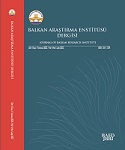XVI. YÜZYILDA KUZEY SINIRINDA BİR OSMANLI KALESİ: YERGÖĞÜ
AN OTTOMAN CASTLE ON THE NORTH BORDER IN THE XVIth CENTURY: GIURGIU
Author(s): Meryem Kaçan ErdoğanSubject(s): International relations/trade, 16th Century, The Ottoman Empire
Published by: Trakya Üniversitesi Balkan Araştırma Enstitüsü
Keywords: Giurgiu; Ottoman; Wallachia; Castle; Trade;
Summary/Abstract: Giurgiu is a settlement located on the left bank of the Danube River that dates back to the Mesolithic Age and where many civilizations ruled. Giurgiu, which has been known by various names in the historical process and has the characteristics of a port town, was named “Yergöğü Öte Yaka” compared to the city of Ruse (Yergöğü Beri Yaka) on the opposite shore after it came under Ottoman rule during the reign of Çelebi Mehmed. From the conquest to the late 16th century, the number of guards was increased in Giurgiu, which was exposed to many attacks and looting of the Crusader army, especially Wallachia; some exemptions were also given to the Muslim and Christian reaya (people) living in the suburbs in return for the protection and repair of the castle. Giurgiu, located on the northern border of the Ottoman Empire, was also directly affected by Ottoman-Wallachian relations. In the town and castle, which became the target point during the conflicts, some events disrupted the peace, such as border violations, banditry, desertions, tax issues, and theft in times of peace. However, the fact that Giurgiu is bordered by Wallachia and its location on the Danube has made the town important politically, militarily, commercially, and economically. Having a large pier, a lively trade, and a lively market, Giurgiu also served as a gateway for Istanbul’s food supply. This article points out the military, demographic and socio-economic status of Giurgiu in the 16th century as a town of the Ottoman Empire with castles and piers. The fact that there was little research in the existing literature on the town during the time frame mentioned earlier motivated this research. The study framework was based on tahrir records, mühimme books, and kanunnames, and the plot of the period was tried to be complemented through chronicles, travel books, and domestic and foreign works.
Journal: Balkan Araştırma Enstitüsü Dergisi -Trakya Üniversitesi
- Issue Year: 11/2022
- Issue No: 1
- Page Range: 125-167
- Page Count: 43
- Language: Turkish

